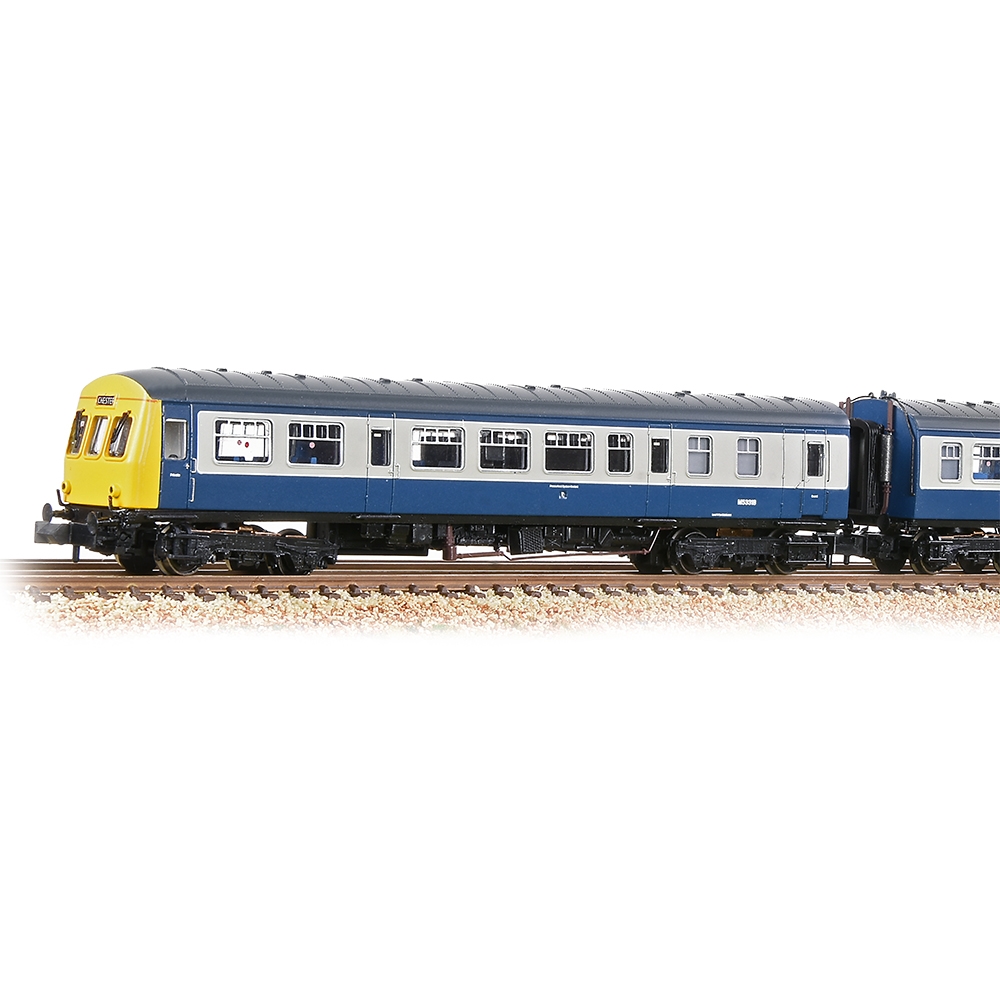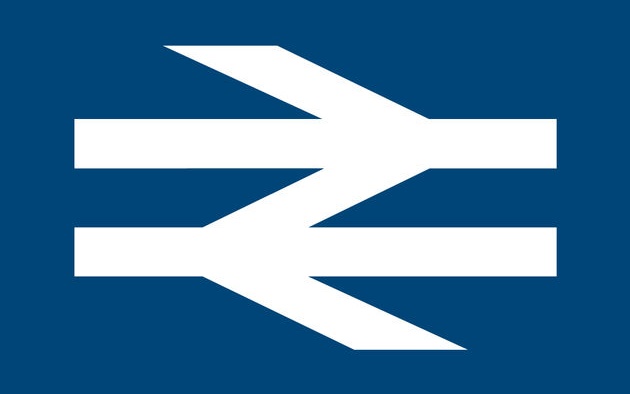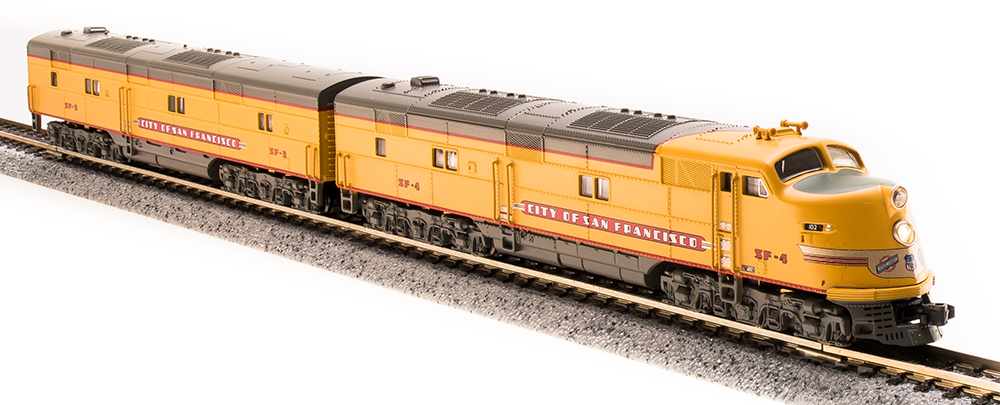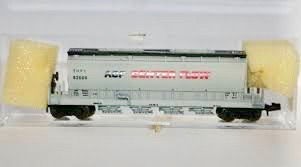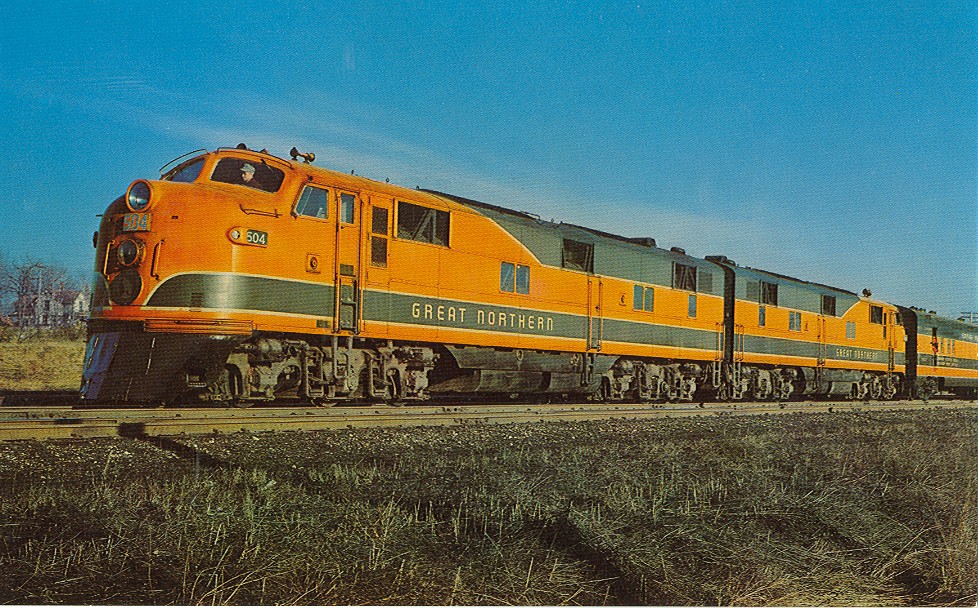Specific Item Information: The Class 101 Diesel Multiple Unit (DMU) was one of the most numerous and widely used types of all the first generation DMUs. Typically formed into two-, three- or four-car sets, the first examples were introduced in 1956 and more than 600 vehicles, including driving vehicles fitted with a cab at one end and corridor gangway at the other, and intermediate cars with corridor gangways at both ends, were built by Metropolitan Cammell at Washwood Heath in Birmingham. Construction continued until 1959.
Initially allocated to the North Eastern, London Midland and Scottish Regions, the units later saw use on the Eastern and Western Regions, with occasional running into Southern Region territory too. Fitted with the Blue Square control system, the Class 101s could work in multiple with other 101s and numerous other DMUs when additional capacity was required.
During the 1970s BR embarked on a refurbishment programme to provide passengers with an improved travelling environment and the Class 101s were used as a testbed for these works which resulted in the majority of Class 101 vehicles being refurbished over a period of almost ten years.
In later years many sets were given an additional makeover to extend their passenger service life, whilst others found new roles carrying parcels, as route learning units and for sandite operations. Around thirty two-car units were still in traffic at the start of the 21st century making the Class 101 one of the final first generation DMUs to remain in revenue-earning service.
The type remains popular today, with more than forty vehicles being preserved and these can now be found operating on preserved railways around the UK.
Initially allocated to the North Eastern, London Midland and Scottish Regions, the units later saw use on the Eastern and Western Regions, with occasional running into Southern Region territory too. Fitted with the Blue Square control system, the Class 101s could work in multiple with other 101s and numerous other DMUs when additional capacity was required.
During the 1970s BR embarked on a refurbishment programme to provide passengers with an improved travelling environment and the Class 101s were used as a testbed for these works which resulted in the majority of Class 101 vehicles being refurbished over a period of almost ten years.
In later years many sets were given an additional makeover to extend their passenger service life, whilst others found new roles carrying parcels, as route learning units and for sandite operations. Around thirty two-car units were still in traffic at the start of the 21st century making the Class 101 one of the final first generation DMUs to remain in revenue-earning service.
The type remains popular today, with more than forty vehicles being preserved and these can now be found operating on preserved railways around the UK.
Road Name History: British Railways (BR), which from 1965 traded as British Rail, was the state-owned company that operated most of the overground rail transport in Great Britain between 1948 and 1997. It was formed from the nationalisation of the "Big Four" British railway companies and lasted until the gradual privatisation of British Rail, in stages between 1994 and 1997. Originally a trading brand of the Railway Executive of the British Transport Commission, it became an independent statutory corporation in 1962 designated as the British Railways Board.
British Rail designed and manufactured rolling stock from 1948 to 1989, at which time its subsidiary British Rail Engineering Limited (BREL) was privatised.
1997 marked the end of the privatization effort in which the last assets of British Rail were sold to 31 regional freight and passenger operators as well as Railtrack (which was later brought under public control as Network Rail), which was given the track and infrastructure.
Read more on Wikipedia.
British Rail designed and manufactured rolling stock from 1948 to 1989, at which time its subsidiary British Rail Engineering Limited (BREL) was privatised.
1997 marked the end of the privatization effort in which the last assets of British Rail were sold to 31 regional freight and passenger operators as well as Railtrack (which was later brought under public control as Network Rail), which was given the track and infrastructure.
Read more on Wikipedia.
Brand/Importer Information: Graham Farish is a British brand of N gauge model trains, that belongs to Bachmann Europe.
The company entered the model train business in the early 1950s, focusing on British OO gauge rolling stock, track and accessories.
In the 1970s, it started to produce N gauge models under the GRAFAR label. After the withdrawal of Lima and Minitrix from the UK market in the late 1980s, Graham Farish was the only major supplier of British outline models in N gauge, soon withdrawing from the OO scale market.
In 2001, Graham Farish was purchased by Kader Industries of Hong Kong, and absorbed by its subsidiary Bachmann Industries. Bachmann immediately closed the British manufacturing facility and moved production to China.
Bachmann have since increased the size of the Farish range, by duplicating models introduced to the Bachmann OO range; often, an OO scale Bachmann Branchline model is followed between 6 months to a year later by an N gauge Graham Farish model.
The company entered the model train business in the early 1950s, focusing on British OO gauge rolling stock, track and accessories.
In the 1970s, it started to produce N gauge models under the GRAFAR label. After the withdrawal of Lima and Minitrix from the UK market in the late 1980s, Graham Farish was the only major supplier of British outline models in N gauge, soon withdrawing from the OO scale market.
In 2001, Graham Farish was purchased by Kader Industries of Hong Kong, and absorbed by its subsidiary Bachmann Industries. Bachmann immediately closed the British manufacturing facility and moved production to China.
Bachmann have since increased the size of the Farish range, by duplicating models introduced to the Bachmann OO range; often, an OO scale Bachmann Branchline model is followed between 6 months to a year later by an N gauge Graham Farish model.
Manufacturer Information: Bachmann, a US company founded in 1835, was purchased by Kader Industries in 1987. Kader formed Bachmann Industries Europe in 1989 with their main UK headquarters in Moat Way, Barwell, Leicestershire, UK (former Palitoy location) and the following year launched the Bachmann Branchline range for the British market with the moulds that had previously been used for the Palitoy Mainline and Replica Railways model railway products. From this starting point Bachmann has developed the range further and now produce a large range of models.
In 2001 Bachmann Branchline bought Graham Farish, an N gauge manufacturer, and since then many of their models have been made available in both gauges.
Bachmann Europe portfolio also comprises other model trains brands such as Liliput.
In 2001 Bachmann Branchline bought Graham Farish, an N gauge manufacturer, and since then many of their models have been made available in both gauges.
Bachmann Europe portfolio also comprises other model trains brands such as Liliput.
Item created by: CNW400 on 2022-03-21 10:14:36. Last edited by CNW400 on 2022-03-21 10:14:37
If you see errors or missing data in this entry, please feel free to log in and edit it. Anyone with a Gmail account can log in instantly.
If you see errors or missing data in this entry, please feel free to log in and edit it. Anyone with a Gmail account can log in instantly.


